When learning to ride a motorcycle, most riders focus on mastering slow-speed maneuvers, evasive maneuvers, clutch control and gear shifts, cornering, and hard braking. However, most riders neglect the most important riding skill - riding over stuff or obstacles on the road primarily because it is one of the most daunting riding techniques to master. In a real-life scenario, riding over stuff on the roads makes riders even more anxious because of the following reasons:
They fail to anticipate the obstacle or just don’t have the skills to ride over it.
At times, the heavy flow of traffic makes it difficult for them to ride past them, compelling riders to ride over it.
The fear of losing control of the bike and lack of confidence.
The fear of causing injuries to others or running into an accident also makes riders hesitant to take on challenging riding situations.
Damaging expensive motorcycle parts and bearing a hefty maintenance bill.
The ability to ride a motorcycle over stuff on the road comes with consistent practice and is no different than learning how to ride. To develop confidence and overcome your fear of accidents and sustaining serious injuries, start with practicing in controlled environments and then testing your skills on the road. Learning how to tackle obstacles on the road is even more important for off-road riding enthusiasts because the last thing an adventure rider wants is to turn around and halt his exploration due to a fallen tree blocking the way, large sections of loose sand, road debris, and slush intimidating you from going further. This article delves deeper into the techniques and riding tips that will help you overcome your fear of riding over road debris and better prepare yourself for these inevitable road conditions.
Table of Content
1. What Kind of Stuff Does a Rider Encounter on the Road?
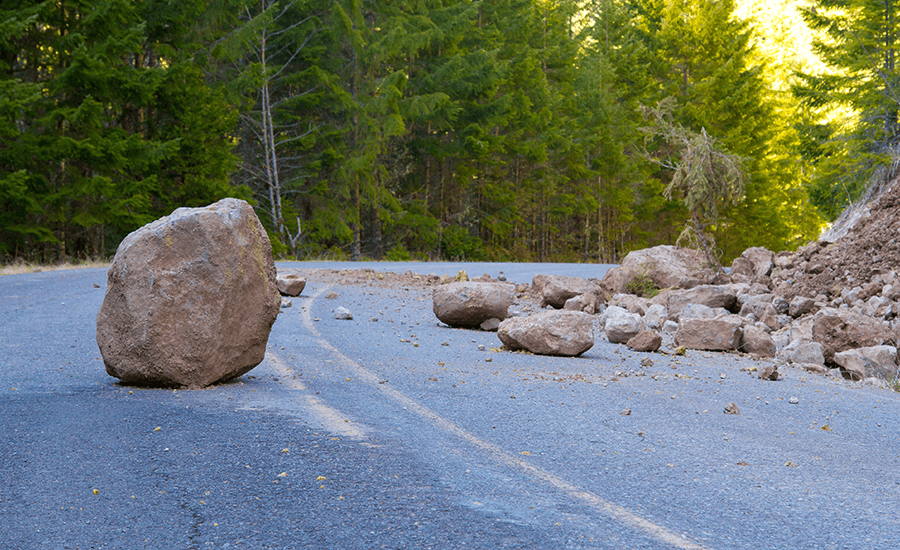
When the term ‘road stuff’ or road obstacles is used, most riders can only think of construction debris, items fallen off another vehicle, or a tree obstruction. However, when practicing how to ride over road stuff, a rider must also consider loose gravel and sand, snow, potholes, unexpected animal encounters on the road, washboard paths, oil spills, sharp rocks, bumps, snow, and slippery muddy paths. Therefore, during your obstacle-riding practice sessions, make sure you use different objects to replicate the real-life scenario. Use worn-out tires, blocks of wood or bricks, small logs, boulders, etc to better familiarize yourself with these obstacles. If you ride an adventure motorcycle, consider riding it on a nearby gravel path or muddy trail.
2. Tips to Ride a Standard Motorcycle Over Stuff on the Road

When riding on a highway or a city street, the last thing we expect is to encounter impediments on the road and have to ride over this stuff. Oftentimes, improperly loaded cargo can fall off the loading trucks onto the highway. Moreover, you may find yourself having to ride over debris from a road accident, unattended construction material or tools, thick branches of fallen trees, and other small items. In these situations, it does not matter whether you are riding a lightweight cruiser, a highly flickable sports bike, a luxury tourer, or a nimble street bike. Contrary to popular belief, your riding skills are more important in these situations than what your bike is capable of doing. The safest way to tackle these obstacles is to ride around them, but if the traffic flow prevents you from it, then utilize these tips:
- When you hit the road, you must prepare yourself mentally so that you can encounter stuff on the road that you would have to ride over.
- Being alert will help you identify the object from afar and also gauge the traffic, allowing you to safely slow down using throttle or brakes.
- As the object draws nearer, try to approach it in a straight line, rev the throttle slightly to give the front wheel a little lift, and use the clutch to move the rear wheel over the object. To avoid loss of traction, make sure you are not approaching the object with your front wheel at an angle because it will cause the bike to tip over.
- As you ride your motorcycle over a bump or a pothole on the road, try to stand on the footpegs to reduce the center of gravity and enhance the bike’s inherent stability. When riding a heavyweight cruiser or a touring motorcycle dressed with motorcycle saddlebags, tour packs, or other luggage bags, standing on the footpegs will be quite challenging. When riding these motorcycles, use your knees to tightly grip the fuel tank to absorb the impact and maintain control.
- Also, grip the handlebars for support and control because once you have pushed the bike over the obstacles, you don’t need to give any clutch or throttle inputs until you get back on the straight road. Firmly gripping handlebars will also keep you from accidentally revving the throttle when your bike’s front has just crawled over the obstacle. Twisting the throttle in this instance increases the risk of rear wheel slip, damaging your bike, or leading to an accident.
- Your motorcycle might not have adequate ground clearance to safely move over the taller obstacles. When riding with luggage or a passenger, the motorcycle tends to ‘bottom out’ and affect handling. In this case, if you manage to ride over the stuff on the road, make sure to move to the emergency lane and inspect the bike for damage. During interstate travels, continuing the trip without stopping to check for damage may cause the bike to experience a mechanical breakdown.
- Practice these techniques to avoid applying hard brakes instinctively whenever you encounter an unforeseen object on the road. Applying hard brakes can make your bike or the suspension system run out of wheel travel to absorb the shock when you make contact with the object to go over it. In both conditions, you will lose control of the bike, and on a traffic-dense street or highway, you will be at a higher risk of running into a grave road accident.
3. Tips for Riding Adventure Motorcycle Over Road Obstacles

When it comes to adventure riding, there are many instances when riders have to ride over stuff on otherwise even gravel paths. Adventure touring motorcycles and dual sport bikes are well-designed to handle these obstacles; however, a certain level of skill is still required to make these motorcycles perform the maneuvers they are engineered for. Here are some tips to help you overcome unanticipated obstacles during your off-road motorcycle escapades.
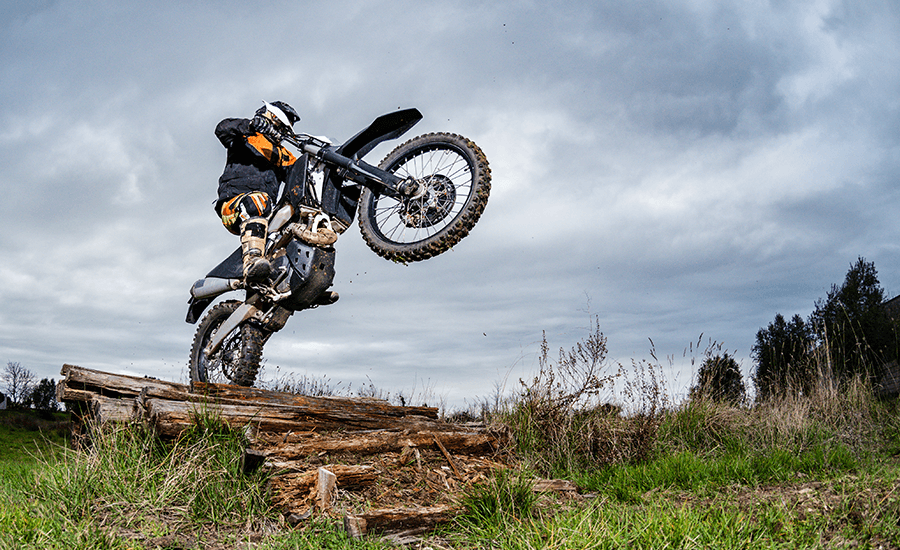
When riding an adventure motorcycle or an enduro over a large obstacle such as a fallen tree, you must take two things under consideration while practicing and riding the bike.
3.1 Determine the Rolling Point of Your Motorcycle and the Obstacles
Pay attention to the rolling point - If you take the axle of the bike at its position and create an imaginary one that runs straight up to the tire, the rolling point of the front tire will be below that imaginary line. On a fallen tree or any similar obstacle, you first need to determine the halfway point of the obstacle, which in this case is a fallen tree, and the rolling point of the tire would be above the halfway point of the obstacle. Usually, the rolling point of the adventure motorcycle or dual point does not match the rolling point of the obstacle. Therefore, a rider needs to loft the wheel to ride over the obstacle, an easy affair on a dual sport or a dirt bike but quite challenging on an adventure motorcycle decked with a luggage system .
The second consideration when riding an adventure motorcycle over a large obstacle is the ground clearance for the skid plate. Though it is not a huge concern, you must be aware of it because if you come off the throttle too soon and position the skid plate atop the obstacle, and if it’s an off-camber section, it may cause your bike to lose stability and tip over.
3.2 Practice Ramp and Kicker Technique
When practicing riding over a large obstacle, try to use the ramp formula or the kicker technique in which you try to reduce the size of the obstacle by placing another smaller obstacle right next to the base of the bigger one and utilizing the throttle to push the front wheel of the adventure motorcycle upwards, preventing the skid plate from making contact with the main obstacle and the motorcycle’s back wheel to easily travel over both obstacles. For this maneuvering technique, you might have to get off your bike to create a ramp yourself. On the other hand, dirt bikes and lightweight dual sports bikes can be easily guided over large obstacles through throttle control. Either way, practice this technique as many times as you can before trying to perform it on an off-road motorcycle trip. If you don’t feel confident enough, try to ride past the hurdles.
When trying to overcome bigger road obstacles, adopt a slow and cautious approach.
3.3 Practice the Throttle and Clutch Controls
Rev the throttle to lighten the front end of a fully-decked adventure motorcycle and give it the lift it requires to ride over the hurdle and pull the clutch to free/unlock the rear wheel, allowing it to effortlessly roll over the ramp and the main obstacle. Even when dealing with smaller obstacles on the road, the throttle and clutch work mostly remain the same.
Start with practicing your technique on smaller objects and slowly work up to larger obstacles.
3.4 Train with an Experienced Rider
- Consider practicing in the presence of an experienced off-road rider or joining a training club that will equip you with the necessary skills required to ride any off-road capable bike over stuff on the roads and gravel paths. Plus, with supervision, you will have someone to help you if your motorcycle tips over due to loss of traction while practicing.
4. Tips for Riding a Motorcycle Over Snow (Wet Stuff on the Road)
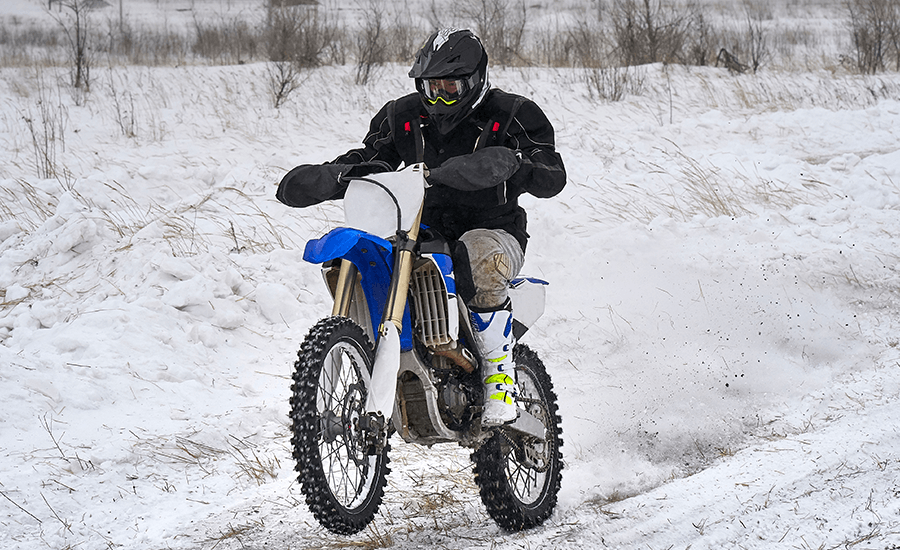
Riding a motorcycle on snow, and the challenging wet stuff on the road can be quite daunting. Oftentimes off-riding enthusiasts get caught in an unexpected snowstorm due to weather fluctuations. It might seem unlikely, but if you are an avid explorer, you might experience these situations while traversing rugged mountainous terrains. In these circumstances, riding an adventure bike, dual sport, or even a dirt bike can be strenuous due to the change in traction. The real thing to recognize to safely navigate these riding conditions includes setting up the motorcycle and utilizing techniques to maintain limited traction.
Whenever a rider hits solid ice on pavement, gravel, or muddy trails, there is a higher unpredictability and anything can happen to the bike in terms of control and stability. The more challenging the riding environment, the more technical your riding should be. Here are some tips to help you safely ride over wet stuff - snow/ice - on the road.
4.1 Riding in Deep Snow or Ice Covered Trails/ Pavement
Ride at a slow pace that will allow you to foresee any obstacles or changes in terrain coming up your way to easily stand on the footpegs.
If possible, try to look for a path with some churned-up and clumpy ice or snow to have some traction for forward momentum. For this, walk the bike on the snow and check if it leaves a tire tread pattern on the snow. Once you find one, try riding on this path.
When having to ride in deep snow, most riders instinctively let go of the clutch and immediately put their feet on the ground when they feel the back tire slipping or the front tire turning or sliding. However, this is not a safe practice because it is necessary to maintain the forward momentum, especially when you are riding uphill. After all, starting all over again will be even more daunting than before.
To keep the forward momentum, make sure you slip the clutch and maintain about 400-500 rpms above what you need to move forward while riding over wet stuff on the road. This way, if you feel the back wheel spinning you can use the clutch to buffer enough power from the rear wheel to reduce the spin without stopping or losing momentum.
4.2 Riding Through Ice Edge Traps
You may also find yourself riding through an ice edge trap, which is a solid flat ice-covered surface, that your front wheel is not able to move up and over. When the motorcycle's front wheel makes contact with such a surface, it will end up moving parallel to the ice edge trap and as soon as the back tire comes parallel to it, the bike loses balance and tips over. If you observe, you will notice that on the other side of this ice edge, there is a small ledge/cliff of ice. Therefore, as soon as you hit the ice edge, turn the handlebars towards this ledge, move the front tire away from the edge, and serpentine it to maintain balance.
When riding on a frozen path, you may find yourself in a situation where your motorcycle’s front tire will be pushing against the ice edge trap and you are not able to move it away or swerve it. With your motorcycle’s front tire moving sideways towards the edge will make you lose balance, you can put one foot to the ground for stability; however, continue riding so you don’t lose momentum.
4.3 Riding on Well-Paved Roads in Freezing Weather Conditions
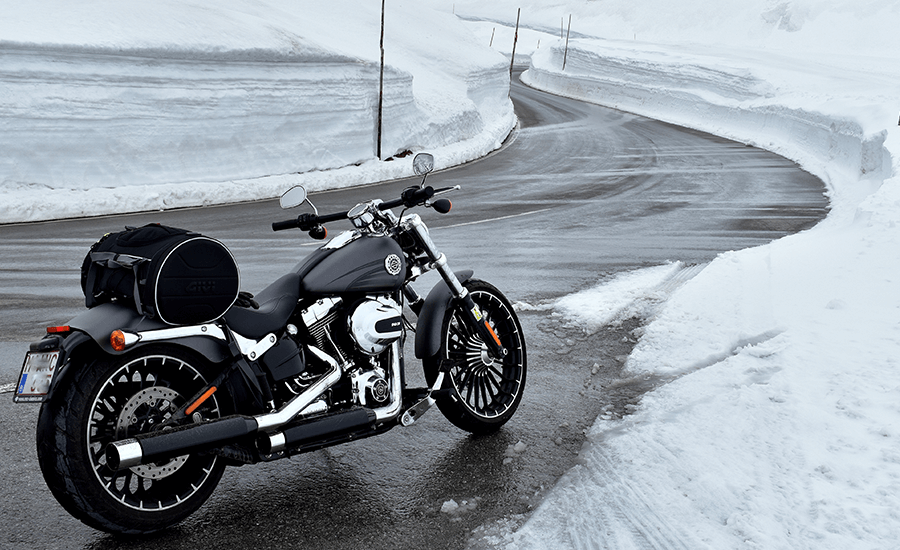
- Once you manage to make it to the pavement, you may think that you will have enough traction to easily ride your adventure motorcycle. However, in freezing temperatures, even the pavement does not offer adequate traction. In this situation, the tires must be warm to gain maximum traction out of the pavement. To safely traverse asphalt in winter, make sure you reduce your bike’s speed and lean angle.
4.4 Riding on Gravel Paths in Winter and Traversing Black Ice
When it comes to riding on gravel paths, winter is by far the best season. This is because riders can comfortably wear all their adventure riding gear without getting overheated and dehydrated. In winter, traction levels on gravel paths are quite predictable. Moreover, the water or melting ice helps create a more cohesive and smooth surface by compressing together and packing all the dust particles. However, it is important to watch out for black ice - an invisible layer of ice that forms on gravel in winter - when riding on gravel paths in freezing weather conditions.
The moisture that helps pack the dust particles on a gravel path and provides a smooth riding surface can also freeze when the temperature drops significantly. These frozen gravel sections also called black ice can make the path quite unpredictable and dangerous, so make sure you watch out for this by keeping your speed low and standing on the footpegs from time to time.
4.5 Choosing the Tire Tread and Tire for Riding on Snow
When riding in snowy conditions or at freezing temperatures, motorcycle tire pressure, and tire tread are two major points of concern because these two factors can help you maximize traction under no-traction riding conditions.
When considering the tire tread, you may need a more aggressive tread pattern for extreme winter on and off-road riding. Although a street-focused adventure motorcycle tire works equally well on gravel and asphalt in freezing temperatures; however, when it comes to traversing slushy/ muddy trails, paths covered with snow, or similar conditions where traction is negligible and you have to paddle the bike, you may need to equip your bike a dirt-biased 50/50 or knobby tires.
The 50/50 or knobby tires are more aggressive, they move and flex more, and generate a greater amount of heat that offers more traction in snowy and wet conditions.
When considering installing tire studs in a motorcycle tire, make sure that the tire tread offers maximum thickness and does not allow the stud to pierce deep into it, resulting in a flat tire situation. For this purpose, get motorcycle-specific studs to rule out the chance of flat tires.
4.6 Adjusting the Tire Pressure for Riding over Snowy Surfaces
- The formula for determining tire pressure is:
Tire Pressure (psi) = Force (lbs)/ Area (in2)
No motorcyclist can dissent the importance of right tire pressure when optimal traction is under question, and to achieve the ideal tire pressure most riders adjust it by filling in or taking out air inside the tire to adapt to the changing traction conditions. However, there is seldom a need to take out or fill in air unless traction in freezing conditions is under discussion. For safe off-roading on gravel paths that may have discreet slick patches of black ice, it is important to meet specific tire pressure requirements. Many riders reduce the tire pressure and rightly so, but without appreciating the underlying concept behind it. The misconceived notion that by slightly deflating the tire, the tire’s surface contact increases and results in traction is quite prevalent. If we take the pressure equation mentioned above, we conclude mathematically that reducing the tire allows the tire to flex and produce more heat. This increase in tire temperature offers much-needed traction when riding on snow.
- When increasing or decreasing the tire pressure, check the recommended tire pressure first. For factory tires, you can refer to the owner’s manual and increase or decrease about 10% of the recommended tire pressure without experiencing any negative impacts. If you are adjusting the pressure of an aftermarket motorcycle tire, check the recommended tire pressure provided by the manufacturer. Though the numbers usually printed on the sidewall of the tire indicate the maximum load a tire can bear and do not always convey the optimal starting pressure for optimal pressure, they can offer a baseline for you to air up or down 10% of the mentioned tire pressure.
5. Last Words
Riding a motorcycle over stuff on the road is a challenging task that requires concentration and excellent riding skills. To ingrain both these qualities, riders need to practice consistently preferably with experienced riders. Most riders believe that practicing riding over obstacles and other stuff on the road is restricted to off-road riding. However, honing obstacle-riding maneuvers can protect you from running into a major crash by sharpening your reflexes, decreasing your reaction time, and transforming you into a refined motorcyclist, capable of navigating any challenge on and off the road. Be sure to practice the tips mentioned above in a controlled environment and if you are a winter riding enthusiast, consider joining a motorcycle training program or camp that will help you master all the tips and tricks mentioned in this article and more.
Also Read: Solo Motorcycle Riding Safety Tips

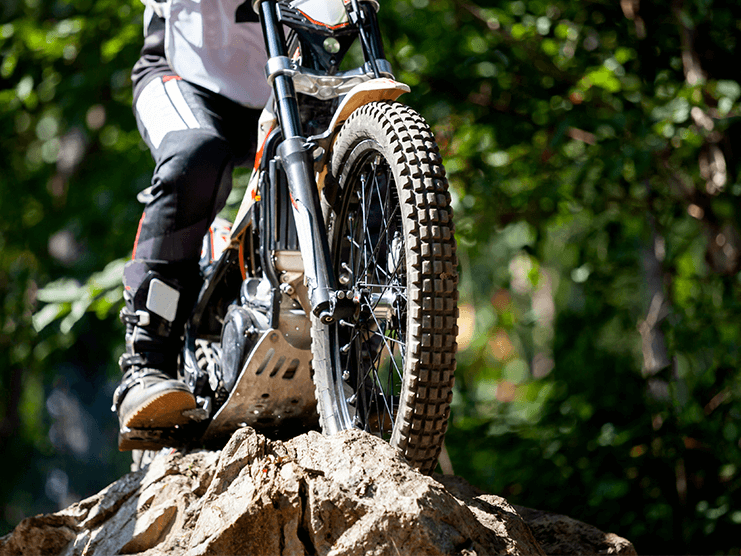











Leave a comment
All comments are moderated before being published.
This site is protected by hCaptcha and the hCaptcha Privacy Policy and Terms of Service apply.